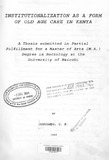| dc.description.abstract | This study investigated the causes and effects
of institutionalization as a form of old age care in
Kenya. Specifically, the study sought to identify the
main factors that led to the establishment of old
people's homes and the adoption of institutional life.
Particular attention was also paid to the pattern of
life in different homes and the effects of
institutional life on the aged.
Eight residential homes were purposively
selected from Mompasa, Kisumu, Trans-Nzoia, Murang'a,
Kirinyaga and Nairobi districts. The target population
was represented by a sample of 148 respondents, which
included an experimental group of 112 randomly
selected old people from the homes for the aged, and
a 'comparison' group of 30 purposively selected old
people living in their OWIT homes. The key instrument
of data collection was the interview schedule,
although unstructured interviews were also carried out
with certain key informants. Information adduced from
the respondents was analysed by aid of a computer
using inferential and descriptive statistics.
The study found that homes for the aged were
mainly established due to ,the disintegration of the
family, which traditionally provided old age care, and
the destitution of the aged resulting from the loss of
xvii
informal care by the family. This was attributed to
the rapid social change that has character ised the
Kenyan society lately.
'l'he major factors that led the aged to
residential care were found to be economic, social and
medical. The most significant was found to be the
economic, contrary to previous findings of scholars
such as Lawton (1980) and Oomen (1991,b). Further, the
effects of lack of social support and poor health were
found to be vitiated by relative or absolute economic
well-being. It is both the economic factor and social
support that also happened to provide the major
difference between the experimental and' comparison'
group, with the latter emerging more advantaged. There
was no significant difference between the experimental
and'comparison' groups with regard to health status as
both were found to be rather low.
Regarding impacts of institutional care, it was
found that, to the majority, institutional life
provided the very basic neccesities that the aged
lacked previously.• In the homes there was at least
some food, shelter, clothing and medical care. This,
however was at the cost of alienation from family and
community members, lack of meaningful relation within
the homes, loss of autonomy,, and fatalism. The impact
of institutional care on the aged was also found to be
dependent upon their socio-economic backgrounds. Those
xviii
who had reasonable socio-economic status found
institutional life a misery, while to the majority who
prey i ously experienced hardships, the impersonality of
institutional life still seemed more desirable.
Life r.n homes was characterized by
Lnact i vity where the majority of the reeiderrst simply
awaited food, sleep and, ultimately death. This was
attributed to the fact that, save for one or two
homes, the majority of the homes lacked adequate
facilities and staff and exhibited a quality of life
which was rather rudimentary.
In view of the foregoing, it was concluded that,
as it is practised presently, institutionalization is
not an appropriate way of caring for the aged in
KenYR. Although .insti t.u t ional care is motivated by
real concerns, it is recommended that other ways and
means of caring for the aged without necessarily
withdrawing t.hem from their communities should be
explored. Specifically, domiciliary care for the aged
was recommended. Alternatively, if institutional care
has to be continued then a supervisory unit should be
estabJished by an able body to vet each new home and
to ensure that the existing ones are maintained and
managed to a particular acceptable standard.
Preferably, residential care for the aged should be
left to religjous organizations which from the
findings seemed to be doing far much better than the
local municipalities. To scholars, it was recommended
that further r e s e a r oh on the impact of
institutionalization of the aged be done with a view
to ascertaining which one, between
institutionalization and domiciliary care, would be
the most approprinte and effective way of caring
for the aged in Kenya. | en |

